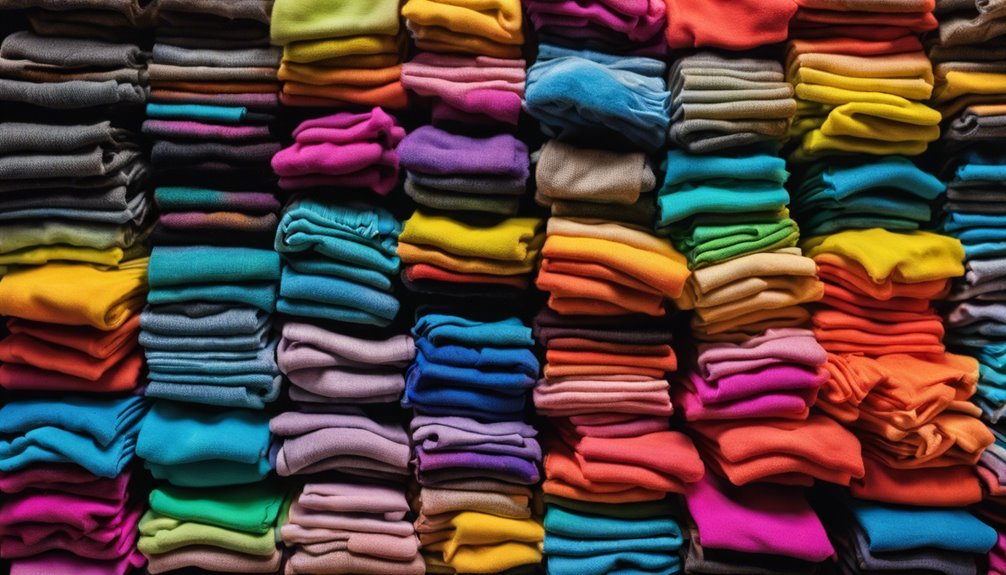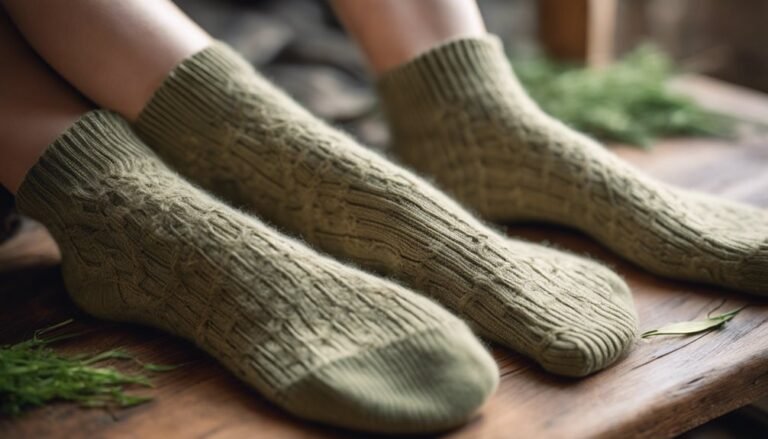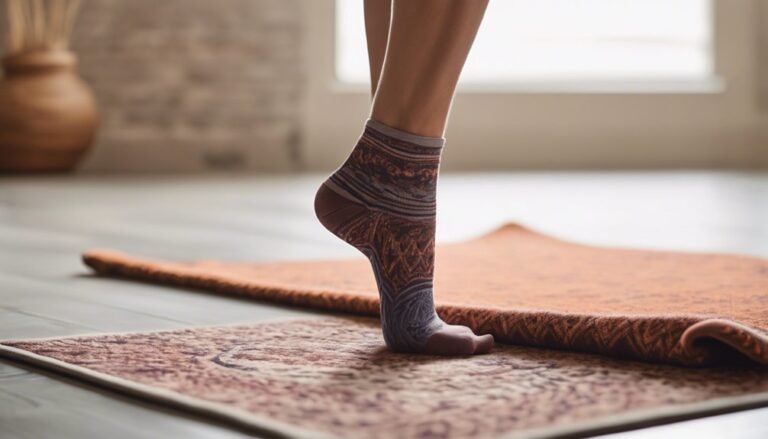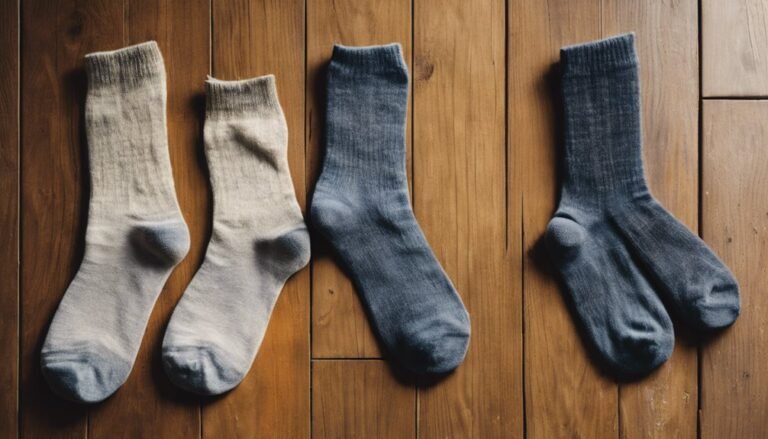Why You Should Wash New Socks Before Wearing Them
Have you ever noticed how new socks sometimes carry a peculiar smell when you first take them out of the packaging? This is often due to the chemical residues, such as formaldehyde, that linger from fabric treatments.
Before slipping on those fresh, colorful pairs, it's wise to wash them to avoid potential skin irritation. Unwashed socks can also harbor loose fibers that may cause redness or itching.
Through the manufacturing process, contaminants like oils and bacteria can be introduced, while dust may accumulate during storage.
Washing not only ensures the socks are clean but also softens the material, providing a more comfortable fit. An initial wash significantly reduces friction against your skin, enhancing overall comfort.
Dive deeper to understand the importance of this simple yet crucial step.
Chemical Residues in New Fabrics

When you purchase new socks, it's important to take into account the presence of chemical residues that may linger in the fabric. Various fabric treatments are often applied during manufacturing to enhance durability, color, and texture. However, these treatments can result in chemical exposure that might be undesirable. The chemicals used, such as formaldehyde and azo dyes, can sometimes remain on the socks' surface. While these substances are intended to improve the product, they can pose potential risks to your skin and overall health if not adequately removed. Washing new socks before wearing them reduces this exposure, ensuring a safer experience. By understanding the effects of chemical residues, you maintain control over your personal comfort and health, aligning with a lifestyle that values freedom and well-being.
Irritation From Loose Fibers
Some might overlook the discomfort caused by loose fibers in new socks, but understanding their impact is vital for maintaining foot health. Fiber shedding occurs when tiny fibers dislodge from the fabric, leading to irritation. When new socks are worn unwashed, these fibers can become trapped between the sock and your skin. For those with skin sensitivity, this can result in redness, itching, or even abrasions. The friction from walking exacerbates these effects, as movement encourages more fibers to shed. While you may prioritize comfort and freedom, it's important to recognize that washing new socks can mitigate these issues. Removing loose fibers before wearing them guarantees a smoother, irritation-free experience, allowing you to fully enjoy your day without distraction.
Hygiene Concerns During Manufacturing

Even though socks seem like a simple garment, the manufacturing process involves numerous steps where hygiene can become a concern. During these processes, socks may pass through various factory conditions that aren't always pristine. You've got raw materials being handled by multiple workers, machinery transferring fibers, and dyes applied in less-than-ideal settings. These conditions can introduce contaminants, including oils, chemicals, and bacteria, which might not be visible but can affect your health.
Factory conditions vary widely. While some facilities maintain strict cleanliness standards, others might not prioritize hygiene. Regulations differ globally, and not all factories adhere to high standards. It's essential to be aware that these variances in manufacturing processes can impact the cleanliness of your new socks, underscoring the need for an initial wash.
Dust and Dirt Accumulation
Although it might not be immediately apparent, dust and dirt can accumulate on socks during various stages of production and distribution. As someone who values freedom, you'll appreciate knowing how these elements impact fabric care and your skin sensitivity. Here's a breakdown:
- Manufacturing Environment: Factories often harbor dust particles due to machinery and foot traffic, which can settle on the fibers of your socks.
- Storage Conditions: Socks stored in warehouses or transit containers may be exposed to airborne dirt, impacting their cleanliness before reaching you.
- Handling by Workers: Multiple hands touch the socks during packaging, increasing the risk of dust accumulation.
Considering these factors, washing new socks guarantees superior fabric care and minimizes potential skin sensitivity, allowing you to enjoy your socks without restraint.
Enhancing Comfort and Fit

Understanding the importance of washing new socks to eliminate dust and dirt naturally leads to another critical aspect: enhancing comfort and fit. When you wash your socks, the sock material becomes softer and more pliable, allowing it to mold to your feet more accurately. This process helps achieve a personalized fit that's not possible straight off the shelf. In its unwashed state, sock material can be stiff, limiting flexibility and causing discomfort during wear. By pre-washing, you guarantee that any manufacturing residues are removed, allowing the natural fibers to breathe and conform to your unique foot shape. This not only provides the freedom to move without restriction but also reduces friction, minimizing the risk of blisters and enhancing overall foot comfort.
Frequently Asked Questions
Can Washing New Socks Impact Their Color or Design?
Coincidentally, washing new socks can impact their color and design. You might notice color fading, yet it's typically minor. To guarantee design preservation, use gentle cycles and cold water. It's all about maintaining freedom in your wardrobe choices.
Are There Environmental Benefits to Washing New Socks Before Wearing?
By washing new socks, you're engaging in sustainable practices that remove potentially harmful fabric treatments. This minimizes chemical runoff, promoting environmental health. It's a small step towards freedom from pollutants, aligning personal habits with ecological responsibility.
How Often Should New Socks Be Washed Before First Use?
For ideal sock hygiene and to guarantee first impressions remain fresh, wash new socks once before their first use. This removes potential contaminants and manufacturing residues, making sure your choice aligns with personal freedom and health-conscious living.
Do Different Sock Materials Require Specific Washing Methods?
Imagine the texture of soft cotton or cozy wool. Each requires specific care: cotton care involves gentle cycles and mild detergents, while wool washing demands cold water and air drying to maintain flexibility and freedom from shrinkage.
Is It Safe to Wear Unwashed Socks for Short Periods?
Wearing unwashed socks briefly might seem harmless, but it can lead to skin irritation and hygiene concerns. You value your freedom, so consider the potential discomfort and bacteria exposure before deciding against a quick wash.







